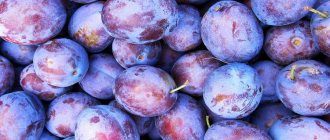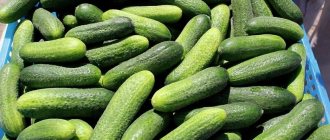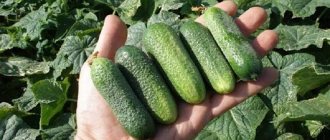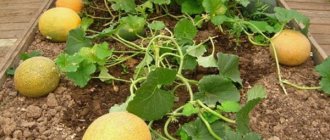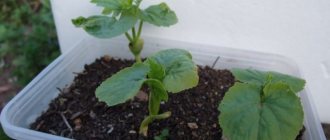Amal melon is an early ripening hybrid created by breeders for growing the plant throughout the CIS. The variety is demanding in care, but it brings high yields, and it can be transported over long distances without any difficulty.
melon variety "Amal"
The average weight is about 3 kg, but often the fruits reach a weight of more than 4 kg
the “Amal” variety pleases gardeners with a good harvest and large fruit sizes
Description and characteristics of Amal melon
The main advantage of the variety is that the hybrid has strong immunity against three main diseases: dry rot, downy mildew and fusarium. Accordingly, the crop will not die from the attack of fungal diseases.
But the crop is valued not only for its strong immunity; large and juicy fruits play a special role; the weight of one can reach 3 kg. If all rules of agricultural technology are observed, it increases to 4 kg.
The fruits of the variety are long with a creamy-yellow skin, smooth to the touch with a thin net. The pulp is darker than the peel, creamy in color with a rich taste and aroma. The chamber where the fruit bones are located is small. 100 g of Amal melon pulp contains approximately 8% sugar. The culture boasts strong roots located along the ground.
When planting 7 thousand plants, you can get about 55 tons of harvest from 1 hectare.
The fruits of the Amal variety ripen almost simultaneously. The large peel does not damage the fruit, so transportation of the crop is excellent. The plant is very demanding on the conditions in which it grows. No unnecessary winds or drafts, regular watering and planting.
How to choose a ripe melon when buying
If you have never grown a melon and want to buy it at the market or in a store, it is important to know about the main signs of quality fruits. First of all, pay attention to the following characteristics of the specimen you like:
- Aroma. The smell of ripe, unspoiled fruits is always clearly visible and has noticeable honey, pear or even pineapple notes. Unripe specimens either emit no aroma at all or give off subtle notes of greenery. Overripe melons, especially if they are slightly spoiled, emit a not very pleasant aroma, which is why you are unlikely to want to buy them.
- Sound. Just like choosing a watermelon, the sound you make when patting a melon can tell a lot about it. Ripe fruits always give off a dull echo, while unripe ones always “sound” loudly.
- External data of the fetus. This criterion is always the most informative, since a visual inspection can assess the color of the fruit, the presence of spoiled areas or mechanical damage, and the uniformity of color. Much in the matter of color depends on the varietal characteristics of the plant, so when purchasing fruits of the Amal variety, you need to remember that fully ripe specimens are always yellow-orange or even brownish.
- Surface elasticity. When you press on the skin of ripe fruits, it will always spring back, but on the surface of overripe melons there will definitely be indentations from your fingers.
- Ease of peeling. If by lifting the skin with your fingernail you can easily separate it from the pulp, it means that the selected melon is well-ripened and ready to eat.
In general, the Amal variety is a good solution both in terms of the versatility of using ripe fruits and in terms of their cultivation, so with a little effort, very soon juicy and aromatic melons with an impressive supply of useful components will appear on your table. If you are not going to grow the crop yourself, then following the above recommendations, you can purchase a ready-made ripe specimen for personal use.
Benefits and calorie content of melon
The tasty pulp of Amala is full of vitamins and microelements. The fruit is eaten in case of loss of strength, anemia and anemia. Melon has a diuretic effect. 100 g of pulp contains approximately 35 kcal, so the fruit will not harm your figure.
However, there is another important factor - the speed of absorption of the product by the body. According to this indicator, Amal is inferior to other cultures. The sugar contained in fruits is absorbed very quickly, resulting in an increase in glucose levels. Therefore, diabetics should approach the use of this product with extreme caution. The glycemic index is high and amounts to 65 units.
What advantages does the Amal melon have and how to grow it on the plot?
Melon is a juicy, sweet and aromatic fruit, rich in vitamins and beneficial microelements. Scientists suggest that the homeland of melon is Asia. Some believe that its origins go back to Africa. This assumption is based on the fact that some wild species of melons still grow in African territory. For example, the Nara melon has long served as a food source in West African territories. In addition, the juicy pulp with a nutty aroma quenches thirst well in the hot deserts of Africa.
This representative of pumpkin crops is a long-liver among melons. The plant can live up to a hundred years, and bears fruit once every decade.
Vegetable, fruit, berry - what exactly is a melon?
Many people argue about what melon belongs to: a fruit, a vegetable or a berry. In botany it is considered a false berry, but in cooking they decided to call it a dessert vegetable. Dessert - because it is sweet, and a vegetable - because it belongs to the genus Cucumber and is considered its variety. Some call the melon fruit a fruit because its pulp is very sweet, which is not typical for a vegetable.
Melon: benefits, calorie content, glycemic index
The tender, aromatic melon pulp is filled with vitamins (A, C, E, B1, B2, B5, B6, B9, PP) and microelements (sodium, potassium, calcium, manganese, copper, magnesium). The juicy fruit is also valued for its low calorie content - 30-38 g (depending on the variety). A melon dessert is unlikely to harm your figure. However, there is another parameter - the rate at which the melon is absorbed by the body. According to this criterion, melon loses to other agricultural crops. The sugar contained in the pulp is quickly absorbed by the body. This leads to a sharp increase in blood glucose levels. Therefore, people who monitor their sugar levels need to know that the glycemic index of melon tends to be high and is 65 units. You can learn more about the benefits of melon here.
Choosing a melon: basic rules
Anyone thinks about how to choose a melon so that the purchase does not become an unpleasant disappointment. When choosing it, you must follow a few simple rules.
- The melon rind should be free of damage, dents, rot, and mold.
- The aroma of melon is very fresh and pleasant. Overripe fruits have a heavy odor. Unripe ones have no smell at all.
- Ripeness is checked in the same way as watermelons - by patting. The difference is that ripe watermelons make a ringing sound, while ripe melons make a dull sound.
- In almost all melons, evidence that the fruit is ripe is a dry tail. Melon was no exception.
- It is better to buy dessert vegetables in stores with a proven reputation, and not pick them up from the roadsides. The pursuit of cheapness can turn out badly. In addition to the fact that melons and watermelons are sold from the ground (at best, from pallets), without documents, they also absorb harmful emissions from cars.
- Everything has its time. This saying also applies to purchasing melons. Melons and watermelons that appear on the shelves in June-July, as a rule, indicate that chemicals were used to grow them.
Features of cultivation
Planting melons in open soil is possible only when the soil temperature is +16 degrees Celsius. A special place is occupied by the distance between seedlings - about 0.6 m, between rows - 1.5 m.
Humus mixed with soil is placed at the bottom of the hole, and seeds (2 or 3) are placed on them. Thus, the gardener independently increases the likelihood that at least one sprout will appear in the hole.
The seeds are deepened by 50 mm and watered. The stems should be above the irrigation hole. During watering, it is impossible to get on the sprout. After the first shoots appear, the weak ones are removed and the strong ones are left.
Agrotechnics of cultivation
Since the Amal melon variety is characterized by increased demands on growing conditions, proper agricultural cultivation technology plays a primary role in obtaining an abundant and high-quality fruit harvest. Starting from choosing the location or timing of planting and ending with the collection of ripened melons, every gardener must adhere to certain simple recommendations.
Dates and place of landing
Among many other melon varieties, Amal can be considered the most suitable option for growing in the central part of the Russian Federation. Being a heat-loving crop, the plant is not afraid of short-term drought, but does not tolerate drafts, and in the same way as it does not tolerate the lack of sunlight. Accordingly, when choosing a site for sowing seeds, you need to focus only on well-lit areas, protected from sharp gusts of wind, with a nutritious and neutral substrate.
Also learn about how to properly form a melon in open ground.
Alkaline soils are not suitable for the Amal variety, since an excess of calcium salts makes the soil hard and increases its density, which is unacceptable for melon.
The best predecessors for the described crop are considered to be cabbage, potatoes and beans. In Western Europe, Moldova, Ukraine and the southern parts of the Russian Federation, where sharp cold snaps are no longer expected in mid-April, you can sow seeds directly into the beds, making sure that the air has already warmed up to +15...+17°C, comfortable for melons, and the temperature the soil reached +10…+12°C (at a depth of 10 cm). However, depending on the specific region, such conditions may occur in late April or even early May.
Sowing pattern and depth
The optimal distance between adjacent holes with Amal melon seeds is at least 70–80 cm, while it is better to leave up to 1.5 m of free space between the rows. Preparing the site for planting melons begins in the autumn, digging up the soil and adding fertilizers to it. Rotted manure is excellent for the role of the latter, at the rate of 4 kg per 1 m² of future planting area.
Did you know? The largest officially registered melon in history is considered to be an Australian fruit grown in 2009. Its weight was 447.5 kg, and the famous gardener turned out to be a resident of the town of Hartberg (Austria) Christoph Schieder, who received a cash bonus of 1.3 thousand for his work .euro.
Having reduced its concentration by 2 times, the fertilizer can be placed directly into the holes (especially if it is planned to plant melon seedlings) or, mixed with soil, evenly distributed over the bed so that under the influence of natural precipitation the organic matter is better absorbed into the ground. When sowing seeds, 3–4 seeds are planted in one hole at once, deepening them into the ground by about 3–5 cm. When planting seedlings, the depth of its planting is calculated based on the size of the plant rhizome and on average is at least 20–25 cm.
Melon planting scheme.
Soil and seed preparation
Preparing the soil for planting includes three main stages:
- Plowing. If the soil is acidic, add lime or dolomite flour to it. It is not difficult to determine the acidity yourself; to do this, just pour vinegar on the soil. If foam appears, the earth is alkaline; if it does not appear, it is acidic.
- Application of fertilizers. Use humus and peat in equal parts as fertilizer.
- Disinfection. Process the seeds and prepare them for planting. Processing: soak the seeds in a manganese solution, keep in it for about half an hour. After this, place the seeds in cold water for a day. In 24 hours they will “wake up”. Then place them on a damp cloth and place them in a warm place. Discard unsprouted seeds.
Description of the Amal melon variety, photos and reviews
The disease-resistant melon variety Amal has proven itself well among amateur and professional gardeners. With proper care, Amal melon will delight you with an excellent harvest and high quality fruit. It is grown in the vast expanses of our Motherland, as well as in neighboring Ukraine and Moldova.
Description and characteristics of the variety
One of the main advantages of the Amal melon variety is its ability to resist the three most common fungal plant diseases - fusarium, downy mildew, and dry rot.
The fruits of the Amal F1 melon have an oblong shape and are covered with a dense, strong, cream-colored skin. The high density of the peel allows the fruit to be transported painlessly over long distances. The plant spreads along the ground, the root system is developed, goes deep into the ground. The melon pulp of this variety has a rich cream color and a pleasant aroma. The melon is easily cut, revealing a small cavity containing the seeds.
Planting methods
Planting methods for Amal melon should be chosen based on your region of residence. If you have a warm climate, then you should plant the seeds directly in open soil; you won’t have to grow seedlings. If warmth comes late to your region, and the summer season is short, then you cannot do without seedlings.
In the northern regions, Amal melon is grown only in a greenhouse; it will not bear fruit outdoors.
Seedling method
In order for the seedlings to quickly take root and germinate well, you should choose the best seeds, without damage, they must have a thick “belly”.
The seeds are treated in a solution of potassium permanganate to prevent the sprouts from picking up various diseases from the ground. They are folded into a damp cloth, covered with another layer on top, and left in a warm place. Those seeds that have swelled are suitable for sowing.
Sowing time
The best time to plant seedlings in the ground is the first half of May. At this time, the soil has warmed up enough and there will be no more frosts.
Melon care
After sowing, watering and slightly compacting the soil in the place where the melon is planted, all that remains is to organize proper further care for the crop, taking into account the required amount of fertilizing, regular moistening of the beds and tillage.
Temporary shelter
Temporary shelter for sown melons is important in regions with possible temperature fluctuations, where spring daytime warmth can quickly give way to night cold snaps, even frosts. Of course, a heat-loving crop will not like such changes, so to prevent seeds or young shoots from freezing, a protective film cover, plastic bottles (convenient for a small number of plants) or spunbond attached to a metal frame are installed over them.
Read more about what a melon is.
The height of the structure can reach 50–60 cm, and the width and length are calculated based on the size of the beds. The structure of the temporary shelter is always made collapsible, so that towards the end of May the protection can be easily removed and, if necessary, quickly installed in another part of the garden.
Watering and fertilizers
You can water the Amal melon only with water well heated in the sun, approximately once every 2-3 days. If possible, it is advisable to perform the procedure in the morning, avoiding contact of leaves with water. To make the task of moistening the soil easier, you can organize a drip irrigation system under the bushes by rolling out tapes between the rows of plantings. When the formed fruits begin to ripen, watering is completely stopped, thereby protecting them from cracking.
Find out why melon tastes bitter.
Fertilize the plants only twice: when the first leaf forms and 2 weeks after that. The best nutritional compositions in this case are considered complex mineral fertilizers or phosphorus-potassium mixtures (50 g) dissolved in a bucket of water.
Weed control
Weeds can choke out any young crop, but melons are especially sensitive to them . Weeds not only take some of the nutrients from the soil, but also protect young plants from the sun, which they really need for rapid growth and development. For this reason, the fight against excess vegetation when cultivating Amal melon occupies one of the main places in the list of basic actions for caring for the crop.
It is most convenient to remove weeds soon after the next watering, since at this time they are easiest to remove from the soil. To get rid of small plants, you can use tweezers, but you should not treat the plantings with chemicals, otherwise there is a serious risk of damage to the crop itself.
Rules of care
After direct planting of seedlings, the holes are watered abundantly with water. Moisture should not get on the leaves and stems. Watering is carried out under the root system with warm water. Often the procedure is carried out at dawn, and with the onset of hot sunny days it is postponed to late evening.
From time to time, the seedlings are watered with a solution of potassium permanganate, thus the soil will be treated against the presence of harmful microorganisms.
If necessary, loosen the soil, but do it very carefully so that the roots are not damaged. Loosening helps air get to the roots faster. Grass and other organic remains should not be stored near plants; everything must be burned. The weeds grow in the first month, then the melon does not allow the grass to grow.
An obligatory step in caring for the Amal melon is pinching. The 1st and 2nd order lashes are kept on the plant, only 1 fruit on them is left untouched, the rest are removed, and pinching is done after 4 leaves. The harvest should be selected when the fruits have reached the plum shape. You need to leave one fruit on the plant - the strongest.
When the first leaves appear, the plants are fed with minerals. 2 g of superphosphate, 1.5 g of potassium chloride and 1 g of ammonium nitrate are diluted in 2 liters of water. Identical feeding is carried out after 14 days. If the soil is poor, then add more potassium and eliminate nitrogen.
If the fruit lies on the ground, then its side may begin to rot; this cannot be allowed. Plywood or wood is placed under the melons. They stop watering the plants 20 days before full ripening, giving them a chance to accumulate a lot of sugar, otherwise the pulp will become watery.
How to grow this variety yourself
Amal is grown in greenhouses or in open ground. Seedlings are prepared at the end of March and planted on the site in mid-May.
Preparing and growing seedlings
Seedlings require a container. Plastic boxes with drainage holes and a tray are suitable. Pour soil into the container, make grooves 1 cm deep. Place 2-3 seeds in each, sprinkle with soil and water with warm water. Place the container in a warm and bright place.
Important! Before planting, seeds are disinfected. The material is soaked in a solution of potassium permanganate or Bordeaux mixture for half an hour. Then take it out and dry it on a clean towel. It is recommended to disinfect the soil for seedlings - place it in the freezer for a day. Low temperatures will destroy dangerous fungi, bacteria and insect larvae.
Caring for seedlings consists of timely watering and fertilizing. Water the seedlings once every 5 days. It is important to prevent the soil from becoming waterlogged, as this will lead to the development of fungus and infections. For fertilizer, liquid organic matter and mineral complexes are used - chicken manure, superphosphate, yeast, nettle infusion. Fertilize once every 15 days.
Growing in stages and care
Amal is planted on soils with low acidity. The lands should be located in a sunny and windless place. To be safe, before planting, lime the soil by adding a mixture of dry lime and wood ash. This composition reduces acidity and makes the soil more nutritious for plant development. The distance between the grooves is at least 70 cm; seedlings are placed in each groove, sprinkled with earth around them, and watered.
Productivity depends on the regime of watering and fertilizing. Water the plant with warm water in the morning or evening. The stream is directed under the root; water should not fall on the stem or leaves. The interval between watering is 5-7 days.
Twice during the growing period, an infusion of nettle or ash is used instead of water . This strengthens the plant’s immunity, develops roots and stems. Two weeks before harvest, watering is stopped.
For feeding, alternate organic matter and minerals. The development of fruits is favorably influenced by the mineral complexes “Zdraven”, “Magic Leyka”, as well as ash, ammonium nitrate, urea, manure, and humus. During the growing period, Amal is fed 3-4 times. For better absorption, fertilizers are applied before watering.
Features of cultivation and possible difficulties
Melon beds need regular weeding. The soil is loosened once a week, the procedure feeds the roots with oxygen, the soil becomes lighter. The depth of loosening is no more than 5 cm. Along with loosening, weeds are removed - bindweed, burdock, nettle. They block the light and prevent the plant from developing normally. Hoes and rakes are used for weeding.
Important! To get a rich harvest, pinch the plant and leave one main stem and 2-3 side ones, the remaining shoots are removed. If the procedure is not carried out in time, many small fruits will form. There is not enough strength for everyone to develop. If the fruits are ripe and large, then a support is built for them from stone or wood. Melons should not lie on the ground, as this will lead to rotting.
For healthy plant development, monitor the amount of mineral fertilizers applied. An excess of phosphorus or nitrogen causes the bushes to wilt, so it is recommended to record the date and amount of fertilizing. To avoid negative consequences, alternate mineral fertilizers with organic ones.
Diseases and pests
Melon is planted in one place for no more than two years in a row. The best predecessors for a hybrid are cabbage, greens, and legumes.
Due to high humidity and improper care, the hybrid becomes ill with viral and infectious diseases, and pests appear. Diseases also occur due to non-compliance with crop rotation rules.
- Powdery mildew appears as a white coating on leaves and stems. The cause of infection is humidity, non-compliance with crop rotation rules, contaminated soil. For prevention, the bushes are sprayed with whey; for treatment, “Quadris” preparations or a solution of copper sulfate are used.
- Root rot appears in beds with weeds and occurs in rainy and hot summers. The base of the stem becomes covered with a gray coating, the plant withers, and the fruits become deformed. For treatment, the beds are sprinkled with dry ash.
- Melon aphids appear in the beds closer to the fruiting period. Midges are attracted by the sweet aroma of the fruits; insects gather on the leaves and feed on the juice. For treatment, spraying with iodine or herbal infusion is used.
- Spider mites affect both young plants and mature bushes. The pest envelops the stems and leaves in a web, taking vitamins from the melon for development. They get rid of spider mites using the Iskra product, and use Bordeaux mixture for prevention.
Saving melons from aphids (Spraying melons BI-58)
Possible diseases and pests
Amal melon is resistant to many diseases and pests, but it is still necessary to take preventive measures.
The main dangers of the variety and their treatment:
- Powdery mildew. Plants are treated with colloidal sulfur (80 g per 10 l of water).
- Downy mildew. Also called downy mildew disease. A solution of potassium permanganate (1 g per 1 liter of water) is used for treatment.
- Fusarium wilt. Occurs on young shoots, get rid of the problem with a solution of potassium chloride.
- Medyanka. Bordeaux mixture (1%) saves fruits.
- Root rot. A formaldehyde solution (40%) is used.
- Melon aphid. Use Karbofos (60 g per 8 liters of water) or laundry soap (100 g per 10 liters of water).
- Spider mite. It is almost impossible to fight it with folk remedies, so the choice should be made on chemicals containing phosphorus or sulfur.
- Wireworm. Crushed egg shells (1 tablespoon per plant) repel insects.
Pests and diseases do not damage the Amal melon if the gardener follows all the rules of agricultural technology.
Characteristics of culture and its advantages
The Amal melon variety is unpretentious, so even novice summer residents can grow a good harvest.
Description of the bush and fruits
The hybrid variety is an early ripening variety. The plant forms a powerful root system. Harvesting begins 65-70 days after emergence.
Oval-shaped melons ripen weighing 2.5-4 kg. The yield of the variety does not disappoint - at least 9 kg of fruits are collected from a square meter plot. The crop ripens at the same time.
The skin of the melon has a dusty cream color, and the flesh is dark cream. The pulp has a rich aroma and juiciness. The seed chambers are small in size. Thanks to their dense peel, melons are well preserved and can be transported over long distances without damage.
Taste and use in cooking
Thin sweet slices originally complement the exquisite taste of mozzarella, ham or shrimp, which is often used when creating menus in cafes and restaurants. Thanks to its juicy pulp, Amal melon is an essential ingredient in fruit salads during the season.
Melon is a self-sufficient product and is an excellent dessert, especially when chilled. In cooking, the pulp is often processed to make juices, ice cream, and cocktails. Cool melon sorbet is a delicious delicacy that is easy to prepare at home. It is difficult for melon lovers to refuse this delicious dessert in winter, so the harvest is frozen or slices are dried.
Useful properties and contraindications of Amal melon
The medicinal qualities of melon are manifested due to the extensive composition of microelements present in ripe fruits:
- antioxidants and special enzymes help normalize the functioning of the gastrointestinal tract, help fight diseases of the nervous system and cardiovascular diseases, and increase immunity;
- the rich vitamin and mineral composition has a positive effect on the appearance of the body - gives shine to hair, moisturizes the skin;
- diuretic and diaphoretic properties appear.
However, you should not eat too much melon, as side effects may occur in the form of pain in the intestines or even diarrhea. Due to its high sugar content, it is not recommended to add melon to the diet of people with diabetes.
Useful tips for growing
Experienced summer residents were able to compile a small list of useful recommendations regarding the Amal melon variety. To get a rich harvest, just follow these tips:
- You can cross melon not only with pumpkin. There are options for connecting with pineapple. The taste of the hybrid is not very different from melon, although not everyone likes it, but the appearance is completely different. The color is bright brown.
- Before planting, always treat the seeds in a solution of potassium permanganate, thanks to this the plant will not get sick.
- Diving is carried out after the appearance of 2 sheets.
- Seedlings are transplanted only when the seedlings are strong enough, otherwise they will quickly die.
Amal melon is an excellent industrial variety. With proper care, summer residents collect a large number of tasty fruits.
Advantages and disadvantages of the variety
The advantages of Amal melon, for which it is recommended for cultivation, are:
- early period of maturation;
- strong immunity, disease resistance;
- high, stable yield;
- drought resistance;
- tasty fruits of good quality;
- good transportability.
Among the shortcomings we can only note:
- lack of resistance to drafts and cold winds;
- growth retardation at low temperatures.
If you adhere to all planting and care conditions, there will be no difficulties in growing the crop.
Reviews from gardeners about the Amal melon
★★★★★
Olesya, 56 years old, geologist, Samara. Two years ago I decided to plant a watermelon on the plot.
I wasn’t particularly happy because the berries didn’t grow as big as I would have liked. Last year I purchased Amal melon seeds. I didn’t think much about the variety, I bought the one the seller recommended. The sprouts grew powerful and quickly got used to open ground. The fruits were formed perfectly. I really liked the variety and will plant it again this year. ★★★★★
Konstantin, 44 years old, breeder, Krasnodar. I love crossing different varieties and types of crops.
This time I decided to cross Amal melon, which I have known for several years, and pineapple. The result was something amazing—dynenas, so to speak. The taste is similar to foreign fruits or berries. The appearance is specific. I suggested that my friends try it, and many were satisfied. Now I’m thinking about growing such a hybrid for sale. Hide
Add your review
Amal melon is an early ripening variety; it is demanding to care for, but the fruits are tasty and juicy. It can germinate in southern and temperate climates; it is extremely difficult to grow in Siberia or Yamal.
0
0
Copy link
Reviews
Hybrid Amal is known among gardeners around the world. Here are a few reviews from Russian summer residents about the harvest:
Polina, Moscow: “The melons grow juicy and aromatic. I plant it using seedlings and the yield is stable. Last season I collected 7 large and heavy fruits from the garden. I recommend for landing."
Alexander, Orel: “ I love melons, especially large ones. I like Amal; it doesn’t require much attention to care for. I recommend planting according to the 50x70 sowing pattern. The leaves of the plants are wide and require free space.”
Ekaterina, Sochi: “I planted Amal last year. The harvest disappointed me. The melons suffered from root rot and did not develop well. I think the reason is the acidic soil.”
Characteristics of the Amal hybrid
It is difficult to grow Central Asian varieties of melons in Siberia and other regions of Russia, where summer ends quickly, so summer residents plant Yamal melon, which manages to ripen in just 60–70 days. Ellipse-shaped fruits differ:
- sweet and tender pulp;
- smooth skin;
- delicate aroma;
- cream color.
The early-ripening hybrid is not afraid of downy dew and dry rot, and is not susceptible to fusarium. Over 50 tons of melons are harvested per hectare, each of them weighs 3–3.5 kg, sometimes 4. They tolerate transportation well, are not damaged, and retain their marketable appearance. For these characteristics, the Amal variety is highly valued by farmers.
Thanks to the abundance of microelements and vitamins, the fruits have medicinal properties. A juicy and sweet dessert speeds up recovery from anemia; melons are useful to consume:
- when the body is exhausted;
- with hormonal imbalances;
- in case of cardiac dysfunction;
- for diseases of the nervous system.
The calorie content of the aromatic product does not exceed 33 kcal per 100 g, so it is included in some diets. The juice is used in the fight against worms.
Harvesting and storage rules
You can get the first harvest as early as August. Signs of ripeness include darkening of the skin and slight separation of the fruit from the stalk. After harvesting, for storage, lay the melons on the ground for 5 days to dry. However, they need to be turned over daily.
Melon Amal is a valuable representative of the melon culture, which has many fans among gardeners. To get a high-quality, and most importantly healthy and tasty harvest, you need to take care of proper planting, and also not forget about the features of further care.
Technology for growing Amal melon: description of the variety, planting methods, photos and video instructions
Melon Amal F1 is an early ripening hybrid of melon, bred at the end of the 20th century in France. This variety is characterized by high productivity and excellent taste, and is not susceptible to a number of diseases.
This article will discuss the characteristics and technology of growing Amal melon.
Description and characteristics
A bright, large mesh is visible on the melon peel
Melon has a high yield - 50-60 tons per hectare when 6-8 thousand plants are planted on this area. The fruits ripen at the same time. The highest taste and rich aroma are characteristic features of this variety of melons.
During transportation, the fruits are practically not subject to damage. This variety, thanks to its qualities and positive reviews from gardeners already familiar with it, quickly gained popularity among farmers and consumers in the European territory of Russia, Ukraine and Eastern Europe, as well as the countries of North Africa and the Middle East.
Planting methods
There are several technologies for growing melon, and they need to be used depending on the region of planting:
- direct sowing of seeds into the ground - suitable for residents of regions with a warm, mild climate (Black Earth Region, southern Russia);
- planting melon seedlings is the most common method used by most farmers and gardeners in the country.
You can also graft a melon onto a pumpkin, but this is a more difficult growing method.
Grafted melon on pumpkin
Amal is the most suitable variety for Russia
Melon is a southern plant that subtly responds to cooling air, high humidity, and dry soil. And most importantly, the “Asian beauty” loves light, warmth and the rays of the sun. In the Russian climate, which is often far from the requirements of the “capricious Asian woman”, for example, in Siberia, growing a melon is a real challenge for a gardener.
The choice of variety largely determines the quantity and quality of the future harvest. But, in any case, for Russian farmers it is best to select varieties with early harvest.
One of the best representatives of early ripening varieties is the Amal melon, suitable for growing in temperate climates.


